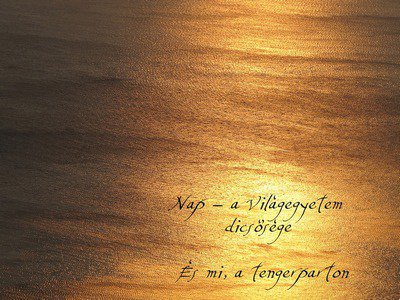Toni Piccini
dal 14/10/2010 al 29/10/2010
Segnalato da
14/10/2010
Toni Piccini
Literary Cafe' House Alexandra, Budapest
Hungarian Rainbows. The artist takes photos in the colour - variety of the rainbow - which expletively represents his haiku.. He often grabs the classical beauty going back to the renaissance era, glamorizing the humanism.

The Hungary–Japan Friendship Society organize “ Hungarian Rainbows “, exhibition of Toni Piccini's Haiga, the first ever Haiga exhibition in Hungary.
“...Toni Piccini does not paint. He takes photos in the colour-variety of the rainbow- which expletively represents his haiku. As Matsuo Basho, the most talented Japanese haiku poet said: „Haiku has an arch, and the 2 edges have a contrary stretched to the breaking point.” So do Toni’ s haigas using the contrary idea between his haiku and the photo, with astounding turns and excellent salto mortale.
His poems often take place in a border-line: now here and eternal life there, micro cosmos and macro cosmos, the line between death and life. Among all of this thoughts, there is always a plus, a mystified feeling. Toni often grabs the classical beauty- going back to the renaissance era, glamorizing the humanism. We could discuss hours and hours about haiga genre, but for now, let’s just take a little look at some poems.
Filled up with pale purple colour, this image tells us the following haiku:
No sky
limits the flight
of a seagull
This is a very Japanese haiga, depicting man's ability to cross any barrier; the superhuman effort small Japanese boys learn about when making and flying kites, and when they put carp-shaped streamer onto rooftops for the children’s day Tango no sekku, since the streamer is the only fish to swim upstream against the river's flow. Thus, this haiga represents masculinity, willpower, and overcoming obstacles.
Another of his haiga brings up the idea of existence and non-existence. On the picture there are two crossed female legs. They are almost identical - but not completely. One is accessorised, decorated by a tattoo and an anklet. The other has nothing, yet it is the one on top, ruling over the one below. The legs are crossed, forming an X, implying irreversibility and an inability to change...”
from the presentation of Judit Vihar
President of Hungary-Japan Friendship Society and Foundation of Japanese Studies,
Professor at Károli Gáspár and Eötvös Loránd Universities in Budapest
Opening October 15th
Literary Cafe' House Alexandra
VII. Karoly korut 3/c. - Budapest



